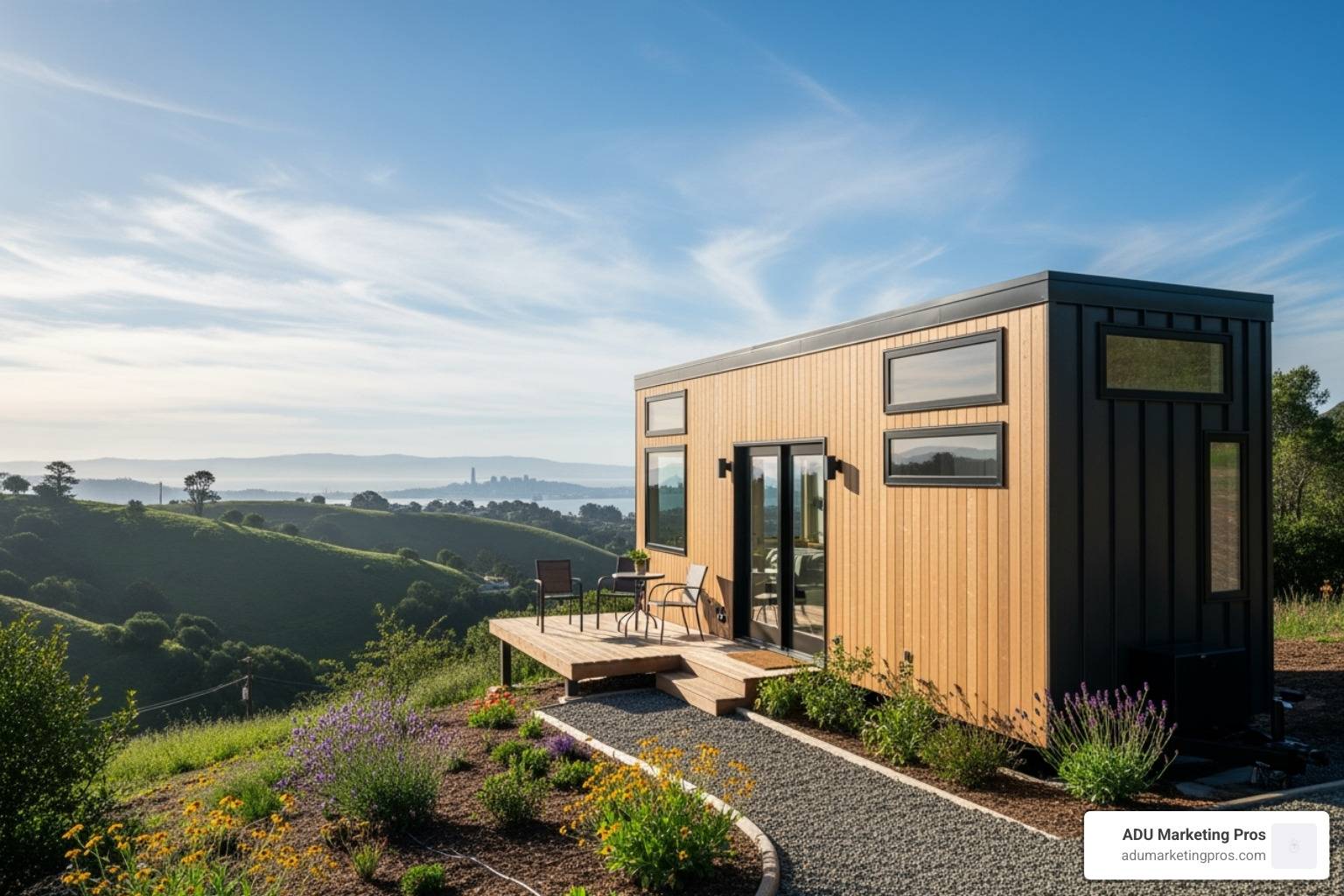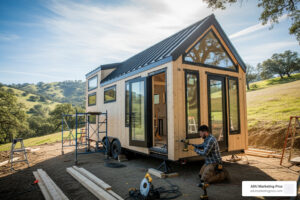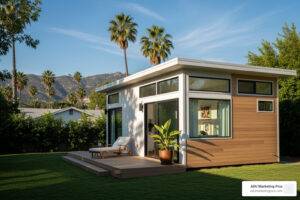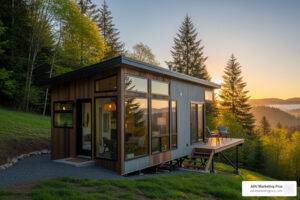Why Tiny Homes Are Changing Bay Area Living
As residents seek creative solutions to the region’s housing crisis, tiny homes bay area searches are skyrocketing. These compact dwellings offer a viable path to homeownership and a more sustainable lifestyle.
Quick Facts:
- Price Range: $6,000 – $80,000+ for the home; $503,000 average with land
- Types Available: Mobile homes on wheels, backyard ADUs, community dwellings
- Legal Status: Varies by city; foundation-built ADUs are the most straightforward to permit
- Best For: First-time buyers, rental income, sustainable living, downsizing
The Bay Area’s housing market has pushed many to reconsider traditional living. With soaring home values and rents, tiny homes have emerged as both a financial necessity and a lifestyle choice. This movement aligns with contemporary values like green living, the maker ethos, and urban homesteading. Offering environmental benefits through reduced energy use and sustainable materials, these homes represent a significant shift in residential trends. From affordable cottages to custom-built ADUs, the market is diverse, but understanding local regulations is the key to a successful project.
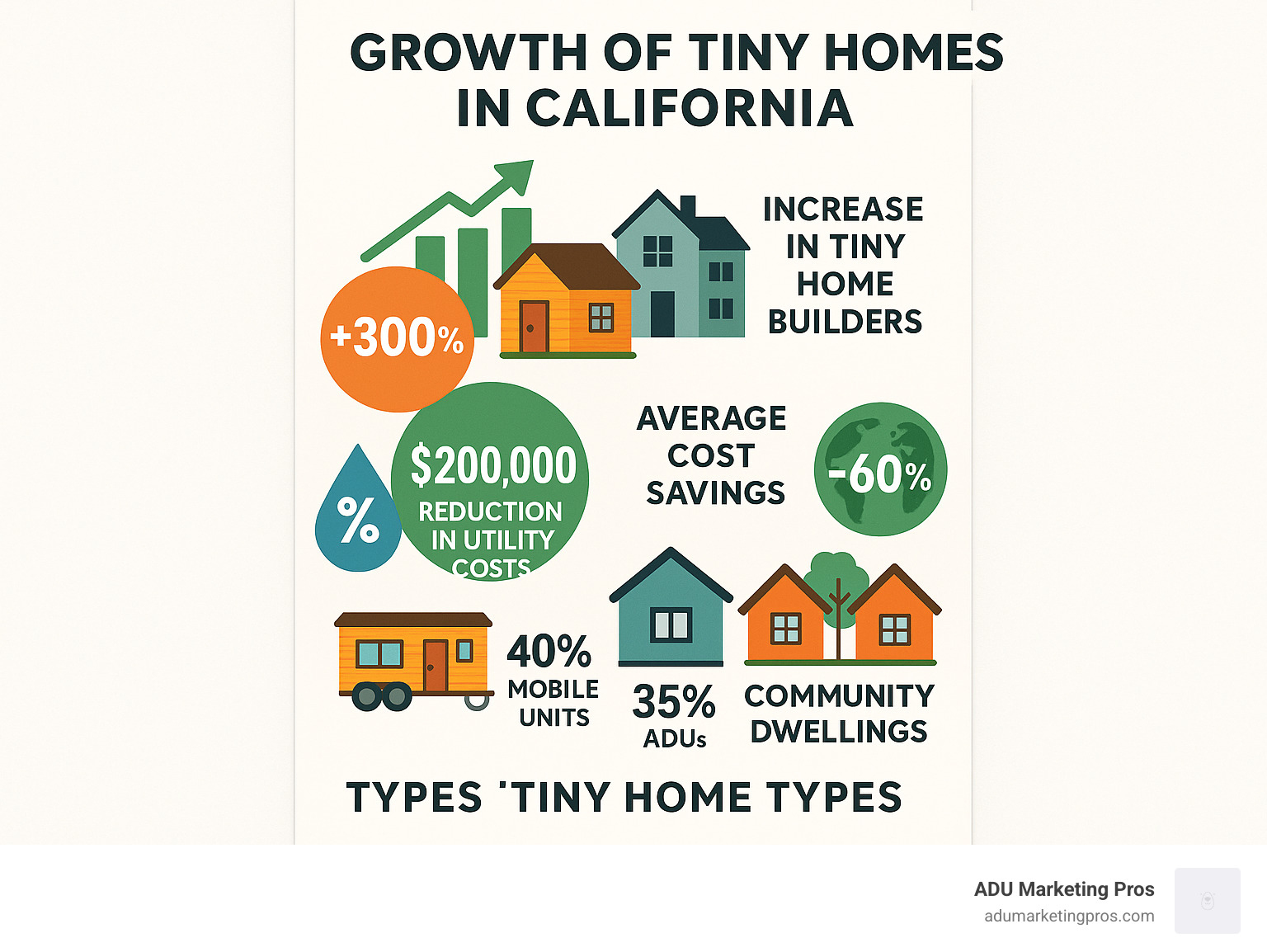
Why the Tiny Home Movement is Booming in the Bay Area
The Bay Area has long been a hub of innovation, and now it’s at the forefront of a housing revolution. As traditional homeownership becomes unattainable for many, the tiny homes bay area movement offers a practical solution and a new way of thinking about home. Families, professionals, and retirees are choosing to downsize not just to save money, but to reclaim their lives from the pressure of high housing costs.
Current Market Trends and Prices
The Bay Area’s housing affordability crisis is the primary driver of the tiny home trend. When median home prices are in the seven figures and rent exceeds $3,000, creative solutions become necessary. This has created a unique tiny homes bay area market.
On one end, tiny homes sold with land average around $503,000. This price typically includes a substantial amount of land—an average of 21.6 acres—making the per-acre cost reasonable for the region. However, for those who can solve the land issue separately (e.g., by building an ADU in a backyard), the home itself is remarkably affordable, ranging from $6,000 for a basic shell to over $80,000 for a high-end model. The peer-to-peer market is active, and for homeowners, the strong demand for smaller units makes adding an ADU an attractive investment, as reflected in current ADU Rental Market Trends.
The Appeal of a Minimalist and Sustainable Lifestyle
Beyond finances, the tiny home movement is fueled by a cultural shift toward intentional living. This resonates deeply with Bay Area values:
- The Maker Ethos: Tiny homes are the ultimate DIY project, offering a hands-on, creative outlet.
- Urban Homesteading: These homes promote self-sufficiency with lower utility bills and efficient use of space.
- Sustainability: Inherently energy efficient, many tiny homes feature eco-friendly materials like recycled denim insulation and salvaged wood. Builders certified as EPA Energy Star Partners are setting high standards for healthy, efficient small spaces.
- Focus on Experiences: With less room for possessions, the focus shifts to relationships, travel, and personal growth.
- Community Connection: Tiny home communities often foster strong neighborly bonds that are lost in many modern suburbs.
For those weighing their options, understanding the key differences is crucial. Our guide on ADU vs Tiny House can help clarify the best path forward.
A Guide to the Top 10 Tiny Homes in the Bay Area
The Bay Area, despite its compact nature, offers a surprising diversity of tiny living options. From ultra-affordable shells that serve as DIY canvases to luxurious, fully-equipped models, there’s a tiny home to suit various budgets, lifestyles, and aesthetic preferences. Here’s a detailed look at 10 common types you’ll find in this vibrant region.
1. The Affordable Contemporary Cottage (Under $50,000)
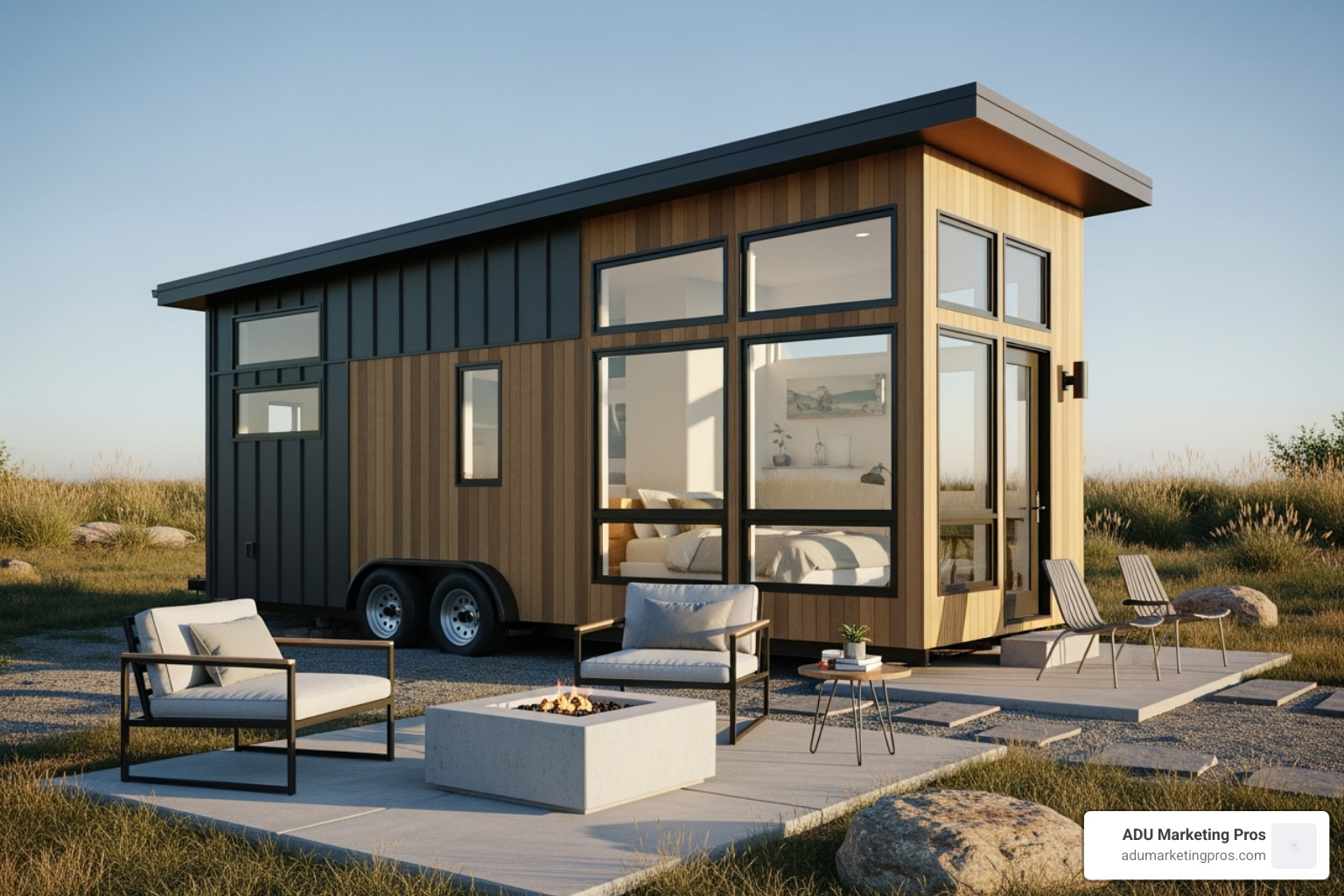
For those who appreciate clean lines and modern minimalism, the affordable contemporary cottage is a popular choice among tiny homes bay area enthusiasts. This style delivers a fresh, uncluttered feel without a high price tag.
Characterized by a sleek flat or gently sloped roof and large landscape windows, these homes feel spacious and bright. A prime example is Pacifica Tiny Homes’ ‘Bay Cottage’ model, which starts around $47,900. At approximately 212 square feet, its smart design maximizes every inch. The abundant natural light creates an airy atmosphere that defies its compact footprint.
Despite the affordable price, these homes are well-equipped. Standard features often include a full kitchen with butcher block countertops, an efficient mini-split system for year-round comfort, and a cozy loft bedroom. A storage staircase, a classic tiny home innovation, provides clever, built-in organization. This style is an excellent fit for individuals or couples seeking a stylish entry into tiny living.
2. The Classic “Tiny Victorian” (Under $50,000)
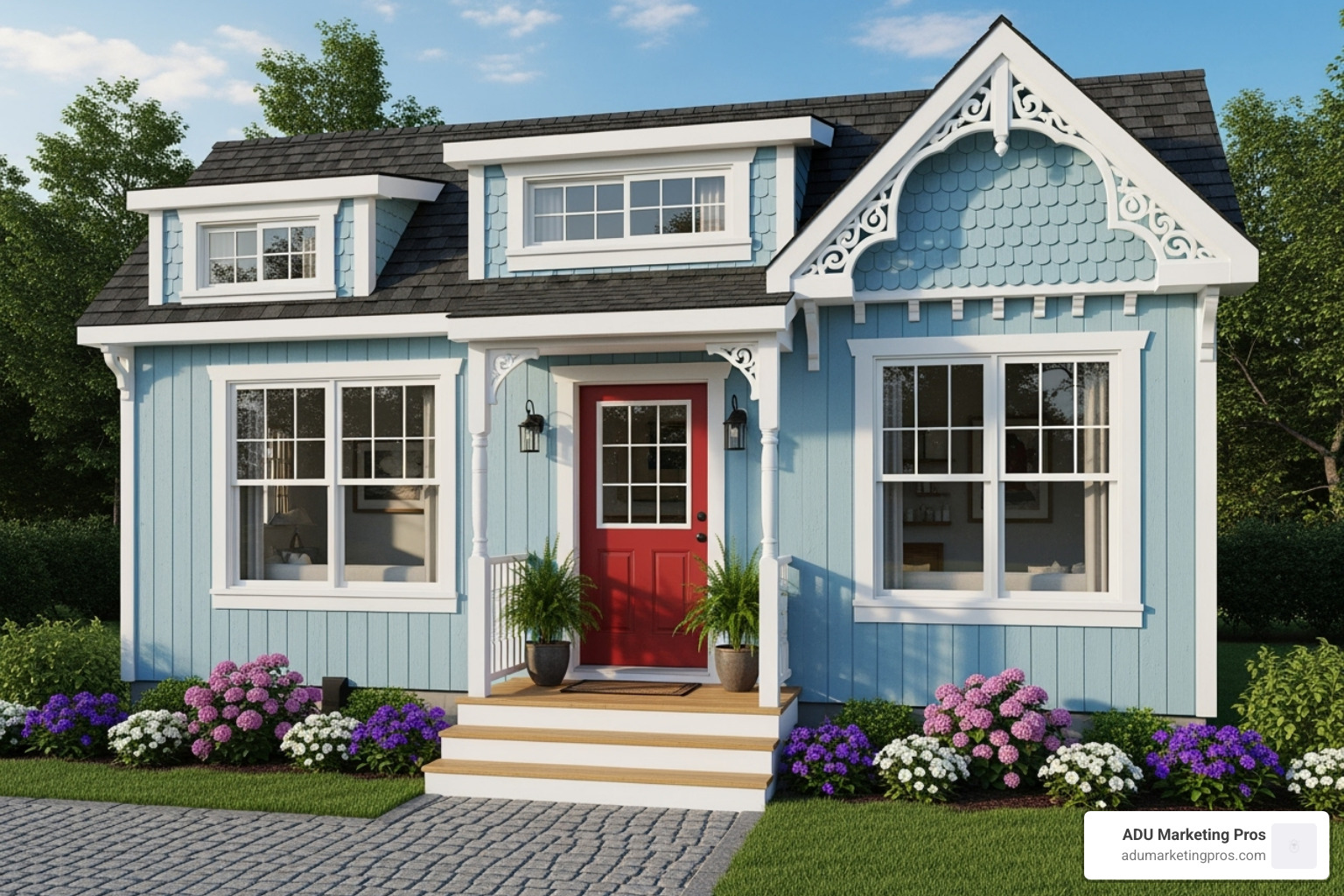
Capture the timeless elegance of San Francisco’s iconic architecture in a compact and affordable tiny homes bay area dwelling. The Tiny Victorian incorporates the charm of the city’s famous homes into a small, efficient package.
These homes feature the classic gable roof and ornate trim work that define Victorian style. At around 212 square feet, they are thoughtfully designed to maximize comfort and function. Large windows flood the interior with natural light, while the versatile layout includes a full kitchen and a clever sofa bed that converts the living area into a bedroom. An efficient AC and heater unit ensures comfort in the Bay Area’s variable climate.
With a starting price of around $49,900, the Tiny Victorian offers an accessible entry into homeownership that doesn’t sacrifice architectural character. It’s an ideal choice for lovers of classic architecture who want to accept the tiny living movement while retaining a connection to timeless design.
3. The Family-Friendly “2.0” Model (Starts at $80,000)
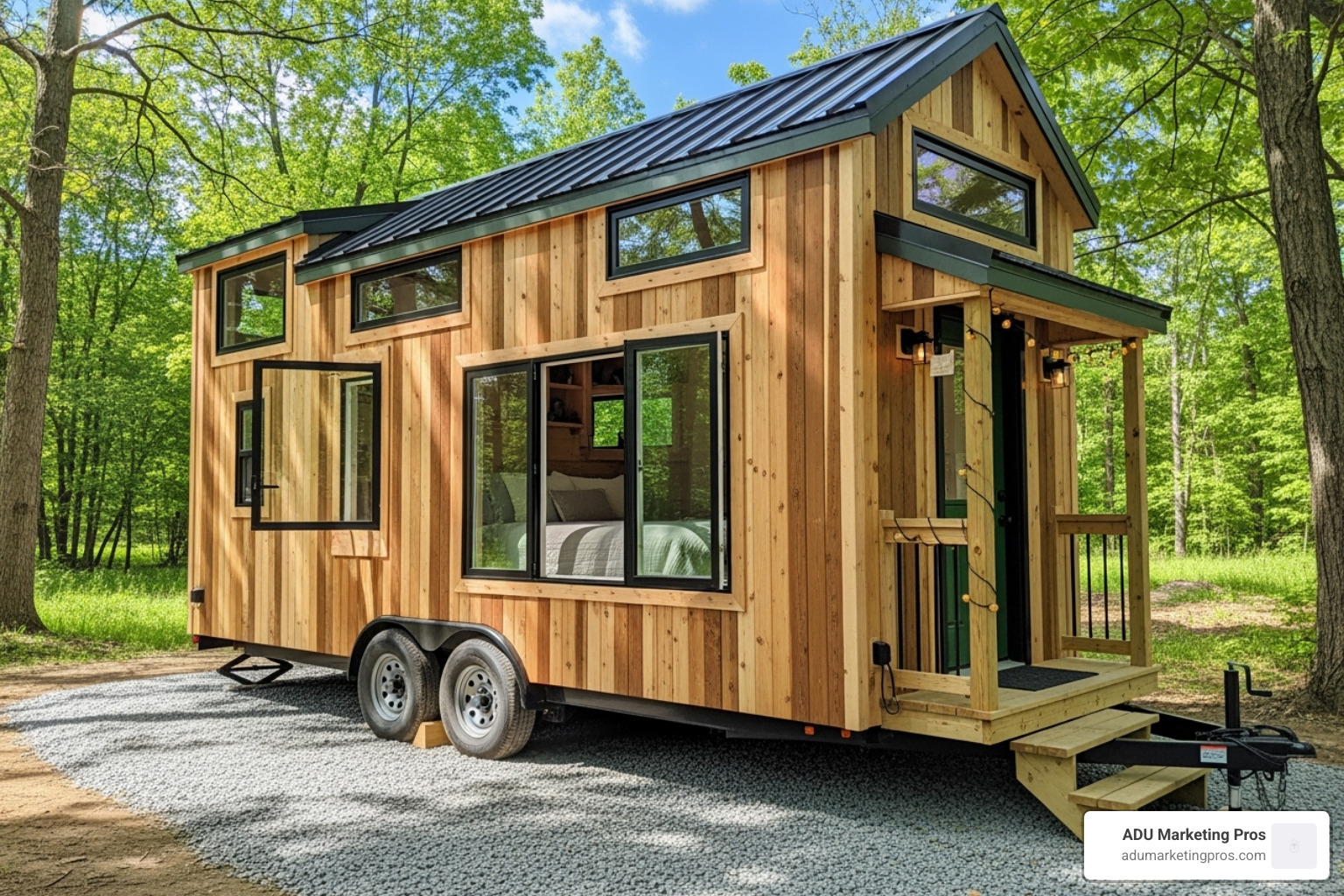
The tiny home movement has evolved to meet the needs of families, as seen in the family-friendly “2.0” models available in the Bay Area. These are not cramped quarters but intelligently designed spaces for family life.
Companies like Pacifica Tiny Homes and Newark Tiny Homes offer models starting around $79,900 that are over 400 square feet. The key innovation is the main floor bedroom option, which eliminates the need for ladders and makes the home accessible for all ages. These larger layouts often include multiple sleeping areas, full-size appliances, and luxury finishes, bridging the gap between a tiny house and a small traditional home.
These models offer a comfortable and functional living environment that works for more than just one or two people. They represent a sweet spot for families, especially those considering a Multi-Generational ADU setup where different generations can live together on the same property.
4. The Backyard ADU Tiny Home
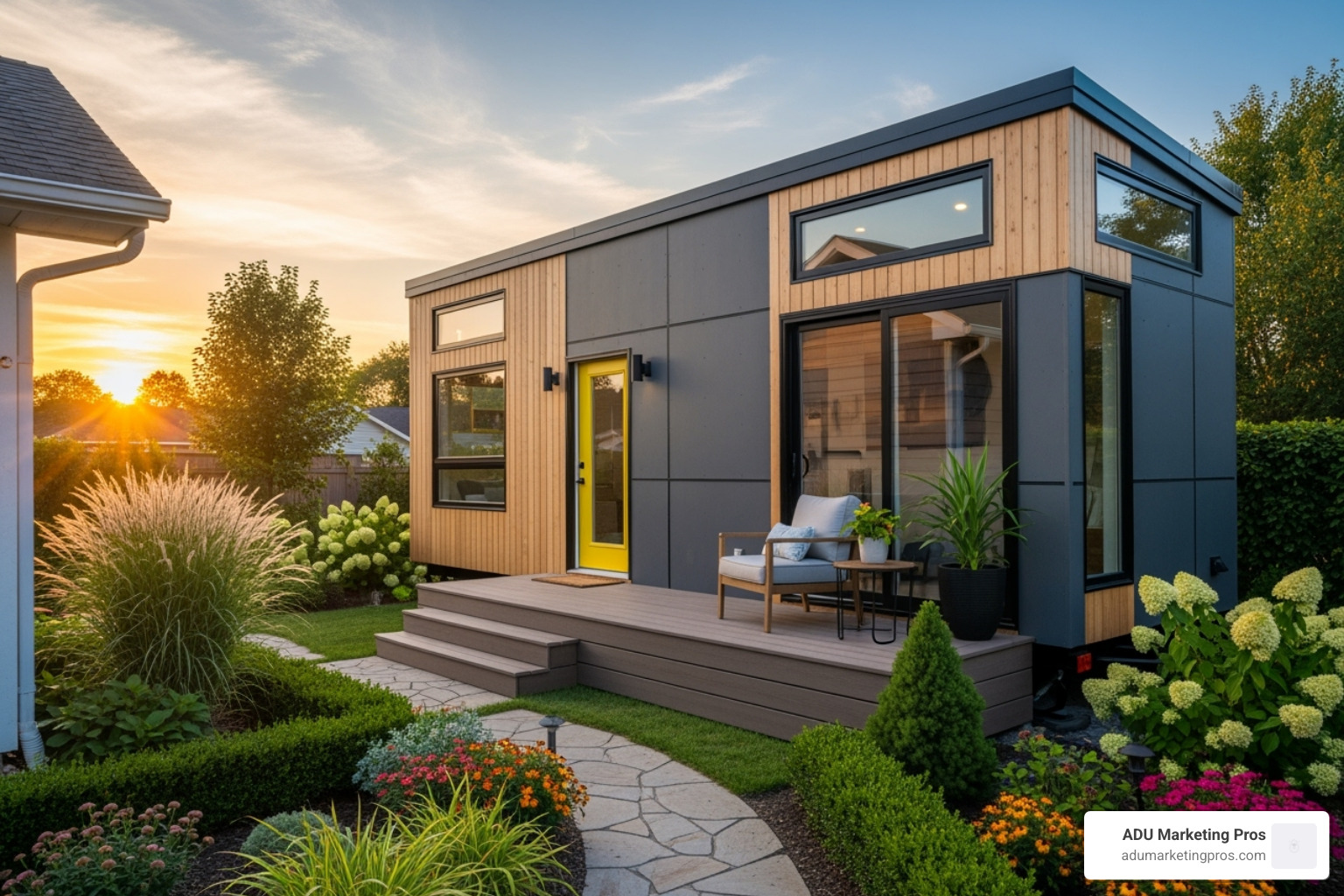
For tiny homes bay area living, the backyard Accessory Dwelling Unit (ADU) is the most practical and legally sound path. Unlike mobile units, these foundation-built structures offer a straightforward way to add living space without the regulatory problems of wheeled homes.
An ADU tiny home combines the principles of tiny living with traditional construction. Companies specializing in this area, such as Alameda Tiny Homes, can complete onsite construction in as little as 90 days. The versatility of ADUs is a major draw. They can be used to generate rental income, house aging parents, or provide an affordable start for adult children. A Garage Conversion to ADU can be a cost-effective way to create these spaces.
Financially, ADUs are a smart move. They significantly increase property value and, as detailed in our guide to ADU Rental Income, can create a substantial new revenue stream. Their permanence and legal standing make them a stable, long-term investment, offering the benefits of tiny living without the uncertainty of mobile units.
5. The DIY-Friendly Shell (Under $30,000)
For the hands-on builder or budget-conscious minimalist, a tiny home shell provides an affordable entry point into the market. These are basic structures with a finished exterior but an unfinished interior, offering a blank canvas for complete customization. A 164 sq. ft. non-toxic tiny house shell in Sebastopol, for example, was recently listed for around $26,000.
These shells allow the owner to create a truly personalized space, choosing their own layout, materials, and finishes. While they require significant work to become livable, they offer ultimate flexibility. This option is best for DIY enthusiasts with the skills and time to complete the project. Using professional ADU Building Plans can provide a solid foundation for such a project.
6. The Artist-Built Unique Creation ($25,000 – $35,000)
The Bay Area’s creative spirit is reflected in its housing, including unique, hand-built tiny homes. Crafted by artists, these homes often feature salvaged materials and one-of-a-kind details. Examples include a 120 sq. ft. tiny house in Oakland listed for $25,000 and a 120 sq. ft. Goldfinch Tiny House in Windsor for $35,000.
These creations frequently incorporate salvaged floors and custom built-ins, reflecting the builder’s personal flair. While they might lack some standard amenities, their charm is undeniable. They are perfect for creatives seeking an inspiring space, perhaps as a dedicated ADU Home Office.
7. The Ultra-Affordable Micro Home (Under $10,000)
At the lowest end of the price spectrum are micro homes—incredibly small, basic shelters for a truly minimalist experience. These units are typically around 100 square feet and can be found for as low as $6,000. Often lacking full plumbing, they are best suited as backyard offices, writer’s huts, or simple guest rooms.
They generally feature insulated walls and a sleeping bunk, providing just enough space for essential functions. While not a full-time living solution for most, they offer an extremely affordable way to add usable space to a property.
8. The Tiny Home with Land Package
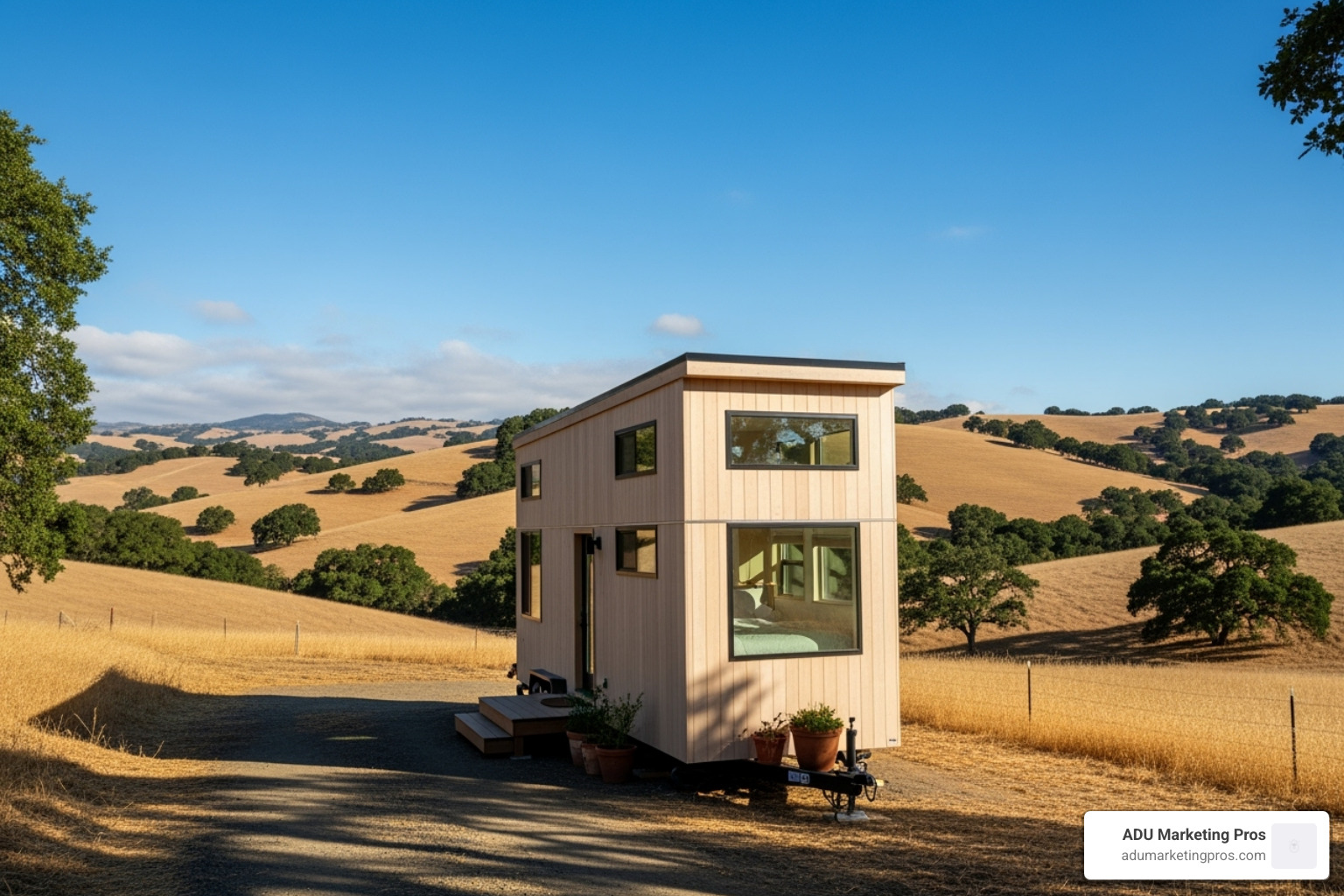
Finding a tiny homes bay area listing that includes land is rare but represents the ultimate goal for those seeking independence. These packages come with a substantial price tag that reflects the value of land in the region.
The average price is around $503,000, but this typically includes an impressive 21.6 acres of land. This breaks down to roughly $23,255 per acre, a reasonable figure for Bay Area real estate. Examples range from a 4.59-acre property in Santa Rosa with a 426 sq. ft. home for $575,000 to a 38.7-acre property in Cazadero with a 672 sq. ft. home for $431,000.
These properties offer unparalleled freedom and privacy. However, they require significant due diligence. Buyers must thoroughly investigate zoning regulations, utility access (water, sewer, internet), and development potential. This option is ideal for those seeking true self-sufficiency and privacy, who prioritize a connection with nature over urban convenience.
9. The Tiny Home Community Dwelling
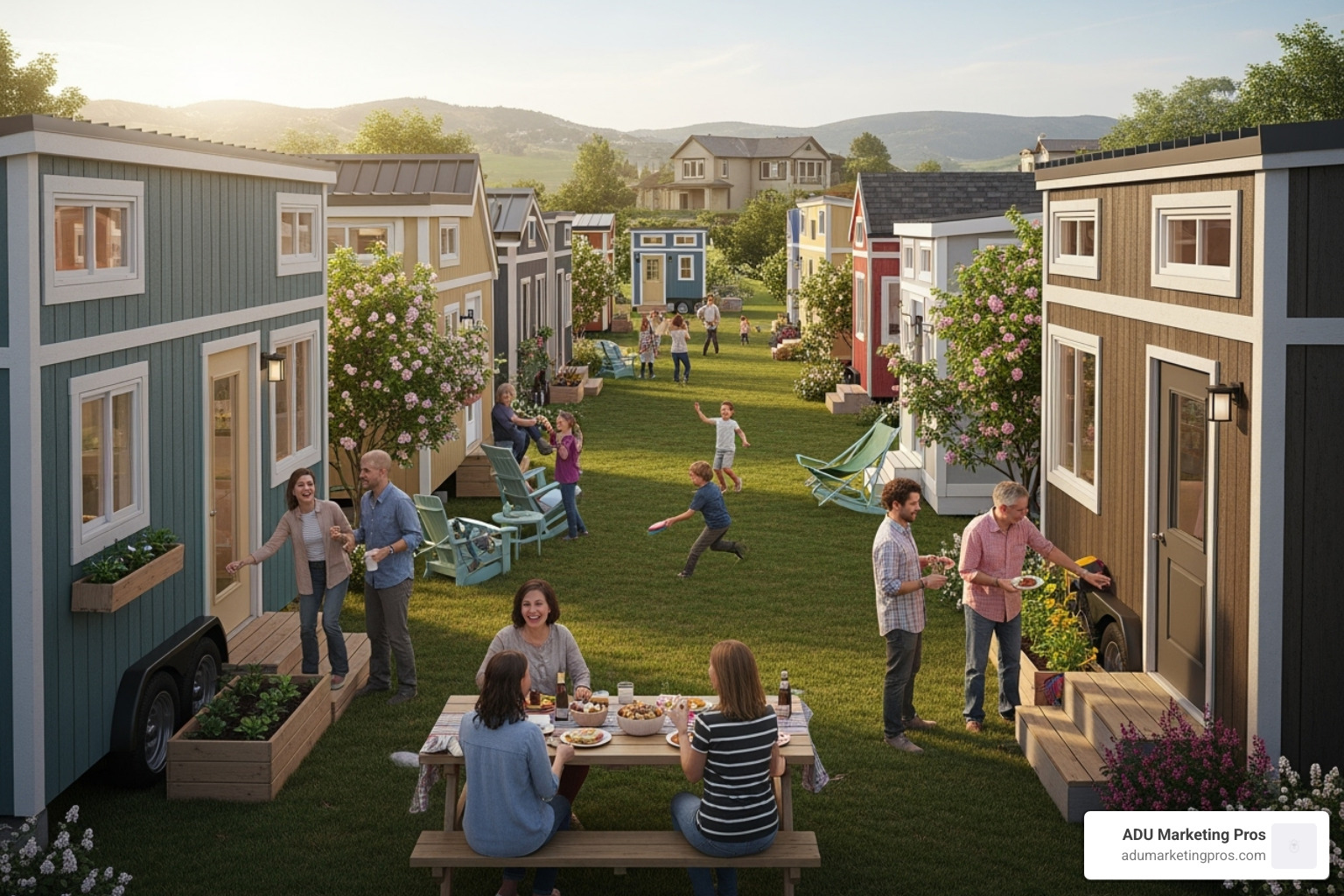
For owners of tiny homes on wheels, finding a legal place to park is a major challenge. Tiny home communities offer a perfect solution, providing legitimate, long-term parking with amenities and social connections.
Delta Bay Tiny House Village, Northern California’s first such community, is a prime example. Located about an hour from San Francisco, it has created a thriving environment where tiny living is celebrated. Residents lease a lot, which keeps costs manageable while providing security. They gain access to shared amenities and a community of like-minded individuals.
There are requirements. Homes must be on wheels, registered with the DMV, and typically be RVIA certified to meet safety standards. As detailed in articles about Delta Bay community life, this model solves one of the biggest problems for tiny home owners: finding a legal, secure, and welcoming place to live.
10. The Luxury Mobile Unit
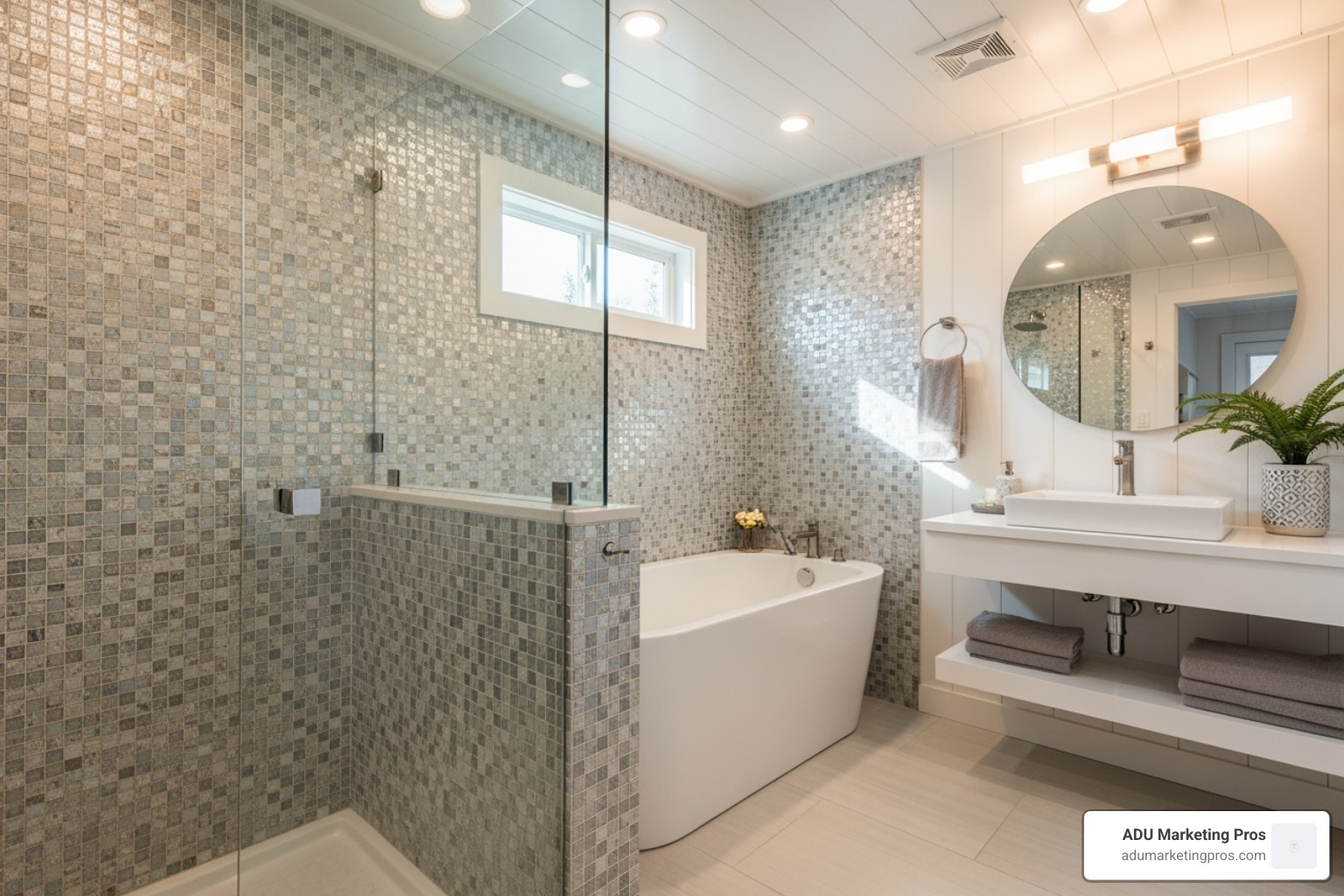
At the top of the tiny homes bay area market are luxury mobile units, which redefine small-space living. Costing well over $100,000, these homes rival high-end apartments in their finishes and features.
Luxury units are defined by premium details: spa-like bathrooms with soaking tubs, smart home technology for controlling lighting and climate, and standard solar panel systems for off-grid capability. These homes prove that downsizing doesn’t mean downgrading.
Many owners use these high-end units to generate passive income through short-term rentals, where the unique experience and luxury finishes can command premium rates. These homes showcase the incredible potential of compact living when budget is not the primary concern, often incorporating cutting-edge ADU Design Innovations. They appeal to buyers seeking flexibility and a high standard of living, viewing the purchase as both a lifestyle choice and a smart investment.
Navigating the Legal Landscape for Tiny Homes Bay Area
Understanding the legal landscape is the most critical step in any tiny homes bay area project. The legality of a tiny home depends on two key factors: whether it’s on a permanent foundation or on wheels, and its specific location within the Bay Area.
California has passed progressive laws to make small-scale housing more accessible, but navigating the nuances is essential to avoid costly roadblocks.
Key Legal Considerations for your tiny homes bay area project
The fundamental distinction is foundation versus wheels, as this determines the legal classification.
-
Foundation-Built Tiny Homes (ADUs): Considered real property, these fall under traditional building codes. This is the most straightforward legal path. State laws have streamlined the approval process, making it easier than ever to build a legal tiny home in your backyard. Always consult the latest California ADU Regulations for current requirements.
-
Tiny Homes on Wheels (THOWs): Classified as Recreational Vehicles (RVs), THOWs face significant challenges with legal parking. Most cities restrict parking a THOW on residential land. However, some cities are becoming more progressive. Oakland’s innovative VRF Program provides a legal pathway for THOW parking, which you can learn about on the city’s official website. Designated tiny home communities are another excellent legal option.
Understanding ADU Regulations in the Bay Area
Accessory Dwelling Units (ADUs) are the most popular and legally viable path to tiny living in the Bay Area. Recent changes in state law have dramatically simplified the permitting process.
While state laws have relaxed many restrictions, specific size and setback requirements still vary by city and county. For example, maximum ADU size can range from 800 to 1,200 square feet depending on the location. Our guide to ADU Size Restrictions offers general information, but you must verify the rules for your specific municipality.
The benefits of the ADU route are clear: increased property value, potential rental income, and flexible living space. Navigating the ADU Permit Process is manageable, especially when working with experienced local builders who understand regional regulations.
How to Finance and Build Your Bay Area Tiny Home
After navigating the legal requirements, the next steps are financing and construction. Financing a tiny home differs from a traditional mortgage, and choosing the right builder is crucial for success.
Financing Your Tiny Home
The right financing depends on the type of tiny home you choose.
- Personal Loans: The most accessible option for many buyers. They are unsecured and can be used for any type of tiny home, but interest rates may be higher.
- RV Loans: An option for certified tiny homes on wheels (THOWs). Lenders require the home to be RVIA certified. These loans often have better rates and longer terms than personal loans.
- ADU Construction Loans: For foundation-based ADUs, these loans are becoming more common. They often convert to a traditional mortgage upon completion and may offer the best terms since the ADU adds value to your property. Specialized lenders like 21st Mortgage Corporation have expertise in this area. Exploring all ADU Financing Options, including home equity loans, is recommended.
Finding a Builder and Key Features
Selecting the right builder is critical. Not all contractors have experience with the unique demands of tiny construction.
When vetting builders, check their certifications, permits, and portfolio. Ask for references from previous clients. California-specific experience is essential due to the state’s unique building codes and energy standards. Our guide to Tiny House Builders California offers insights on what to look for.
Key features for a Bay Area tiny home include quality insulation to handle microclimates, smart storage solutions, and a functional layout that maximizes natural light. Energy efficiency is also a priority, both for sustainability and for keeping utility costs low. Taking your time with financing and builder selection will have the biggest impact on your budget and your overall tiny living experience.

